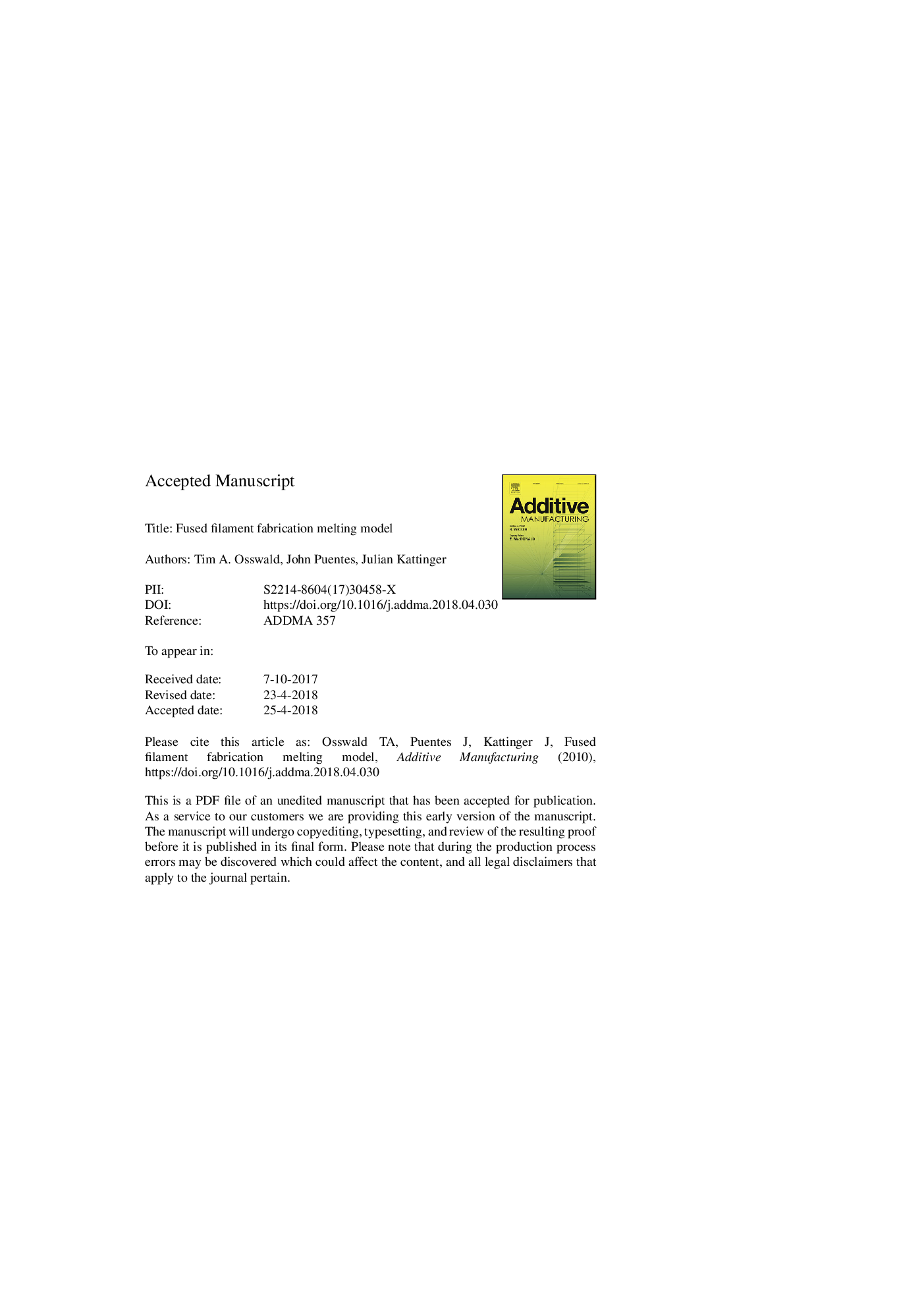| کد مقاله | کد نشریه | سال انتشار | مقاله انگلیسی | نسخه تمام متن |
|---|---|---|---|---|
| 7205704 | 1468627 | 2018 | 31 صفحه PDF | دانلود رایگان |
عنوان انگلیسی مقاله ISI
Fused filament fabrication melting model
ترجمه فارسی عنوان
مدل ذوب ریخته گری سنتز شده
دانلود مقاله + سفارش ترجمه
دانلود مقاله ISI انگلیسی
رایگان برای ایرانیان
کلمات کلیدی
ترجمه چکیده
این مقاله یک مدل ذوب تحلیلی را در داخل نازل یک فرایند تولید رشته های تلف شده ارائه می دهد. این مدل سناریوی محدود کننده ای را ارائه می دهد که در آن حداکثر نرخ ذوب توسط نیروی اعمال شده کنترل می شود. در اینجا، به جای داشتن یک نازل پر از ذوب پلیمر، ذوب به سمت یک فیلم ذوب در نوک رشته کاهش می یابد، زیرا آن را در برابر خروج نازل فشار می دهد. این مدل از حالت ذوب استفاده می کند که توسط ذوب شدن با حذف جریان ذوب جریان تحت کنترل قرار می گیرد. این مدل شامل اثرات دمای اولیه رشته، دمای بخاری، نیروی اعمال شده، زاویه نوک نازل، قطر و طول مویرگی و همچنین خواص رئولوژیکی و حرارتی است. راه حل تحلیلی با آزمایش های کنترل شده بر روی یک طراحی ویژه طراحی شده مقایسه شده است. علاوه بر این، مدل برای ارزیابی اثر زاویه نوک نازل، دماسنج و دمای رشته اولیه بر میزان ذوب در نازل استفاده می شود. مقایسه بین آزمایش ها و مدل نشان می دهد که فرض هایی که برای توسعه مدل مورد استفاده قرار می گیرند قابل اعتماد است و این مدل می تواند برای بهینه سازی ذوب در فرآیند تولید افزودنی اکستروژن مواد و همچنین پیش بینی عملکرد مواد جدید مورد استفاده قرار گیرد.
موضوعات مرتبط
مهندسی و علوم پایه
سایر رشته های مهندسی
مهندسی صنعتی و تولید
چکیده انگلیسی
This paper presents an analytical melting model inside the nozzle of a fused filament fabrication process. The model presents the limiting case scenario where the maximum melting rate is controlled by the applied force. Here, instead of having a nozzle filled with polymer melt, the melt is reduced to a melt film at the tip of the filament as it is pushed against the exit of the nozzle. The model uses a mode of melting that is governed by melting with pressure flow melt removal. The model includes effects of initial filament temperatures, heater temperature, applied force, nozzle tip angle, capillary diameter and length as well as rheological and thermal properties. The analytical solution is compared to controlled experiments done on a specially designed set-up. Furthermore, the model is used to assess the effect of nozzle tip angle, heater temperature and initial filament temperature on the melting rate within the nozzle. The comparison between the experiments and the model show that assumptions used for the model development are plausible, and that the model can be used to optimize the melting within a material extrusion additive manufacturing process, as well as predicting the performance of new materials.
ناشر
Database: Elsevier - ScienceDirect (ساینس دایرکت)
Journal: Additive Manufacturing - Volume 22, August 2018, Pages 51-59
Journal: Additive Manufacturing - Volume 22, August 2018, Pages 51-59
نویسندگان
Tim A. Osswald, John Puentes, Julian Kattinger,
